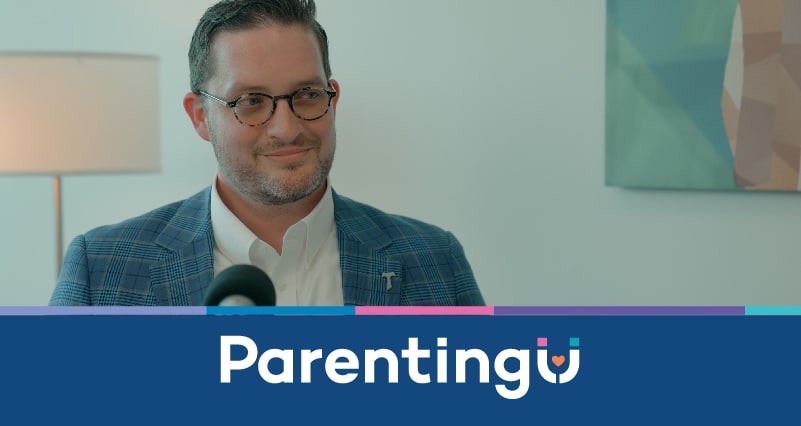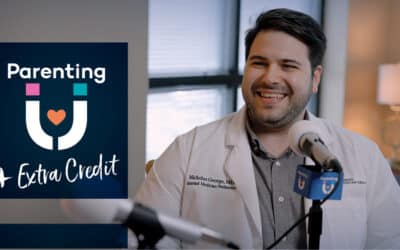Seizures in children are scary, and parents understandably have questions and concerns.
Kenneth Habetz, MD, pediatric neurologist with Our Lady of Lourdes Women’s & Children’s Hospital, shares what parents should know about seizures and epilepsy in this ParentingU podcast episode.
Understanding Seizures
A seizure is abnormal electrical activity in the brain that correlates with some clinical change such as jerking, stiffening, falling out or even more subtle eye or facial twitching.
In addition to what Dr. Habetz calls “TV seizures,” those with large convulsions that are clearly frightening, seizures can also be more subtle, abnormal movement with abnormal mental state, confusion or change in personality.
Any recurrent, unusual thing that looks the same every time should be investigated.
Febrile Seizures
If a seizure includes fever in children of between 6 months and 6 years of age, it’s a febrile seizure. These are generalized convulsive seizures, and most children grow out of them.
There’s debate about what triggers febrile seizures, and no one knows why some children are prone to having them.
What to Do During a Seizure
When a child has a convulsive seizure it’s important to put them on their side and don’t put anything in their mouth. It doesn’t matter which side, although if only one side is seizing keep that side up to lessen carpet burns.
Keeping the seizing person in a safe, ground level position on their side prevents choking on saliva. Nothing in the mouth to avoid chipping teeth. During a seizure that is not convulsing the main thing is to keep them safe and out of harm’s way.
Panic during a seizure, especially the first time, is normal, and calling 911 can be appropriate to get trained personnel to help when parents aren’t sure what to do.
Dr. Habetz recommends the Epilepsy Foundation’s website, including their seizure first aid one-pager, as a resource for his patients and their parents.
Seizure Evaluation and Treatment
Often after a first-time seizure a child will undergo some tests, one of which is an EEG or electroencephalogram. This will read brainwaves and may point to an increased risk of repeat seizures or a diagnosis of epilepsy, which requires medication.
In children who are already at increased risk of having a seizure, such as children who were born preterm, have cerebral palsy or brain injury, would start medicine after a first seizure.
Using a cell phone to video the abnormal things can help with diagnosis, as sometimes the subtle details matter. When recording a seizure or possible seizure, try to show the whole body, remove any covers and ensure face and arms are visible in the frame. Video can be invaluable to diagnosing and it can also relieve parents of having to relive and retell such a scary moment over and over.
Diagnosing Epilepsy
With epilepsy the brain is generating the seizures itself. A diagnosis can be made when there are two seizures that are unprovoked, meaning there isn’t an underlying issue that caused the seizures; one seizure with underlying diagnosis that predisposes more seizures; or one seizure with an EEG that looks like the same.
When diagnosed with epilepsy, a child will take medication daily, and there are about 30 options. Medication diminishes the chance of breakthrough seizures with the goal being to get off medication when you’re at less risk of seizure.
Good News
Most people who have a first-time seizure don’t have more.
And most children who are diagnosed with epilepsy will grow out of it.
Just like you grew into the problem, you can grow out of it. Medications can usually prevent seizures in that window of vulnerability, then grow out of it and can stop the medication.
Living with Epilepsy
The goal is for a normal childhood with medicine, but there’s always a psychological and stress component. Parents’ worry is part of the disease burden. Those fears are legitimate, and there are ways to mitigate them, especially by having contingencies, plans and backups.
Rescue medication can help stop a seizure if it goes too long. And monitoring, which might mean a wearable or an auto-recording baby monitor if a seizure happens at night.
After trying two medicines and “failing,” which means having another seizure or too many side effects, then non-medication options would be considered.
The first is the ketogenic diet, which is hardcore and typically initiated inpatient with a nutritionist’s assistance. Almost all calories must come from fat, causing the body to create ketone bodies, which are anticonvulsant. Sugar does not cause seizures, however.
Another treatment is a VNS (vagus nerve stimulation), a little box like a pacemaker, that stimulates the vagus nerve, reducing the number of seizures.
Brain surgery to remove the part of the brain that’s causing seizures can provide permanent seizure freedom. But it is very complicated and only considered after not responding to treatment and knowing where in the brain the seizures are coming from.
Understanding Pediatric Neurology
A pediatric neurologist treats diseases of the brain, spine, muscles or nerves. While seizures are one of the common things these specialists see they also treat developmental delay, autism, migraines, cerebral palsy and more.
Dr. Habetz is from Ragley, La., and he returned to his home state after extensive specialty training to be near family and to bring this important specialty care to Acadiana patients. He also keeps an open line of communication for pediatricians across Louisiana who have neurology questions or need advice for their patients.
As a children’s health network our goal is to make sure patients can get the treatment they need when they need it as close to home as possible.
When you’re worried, be worried. Your first step is to talk to your pediatrician who can refer you to a specialist. Connect with one of our exceptional providers:
-
Find a pediatric provider in Baton Rouge.
-
Find a pediatric provider in Acadiana.
-
Find a pediatric provider in Northeast Louisiana.
-
Find a pediatric provider in Bogalusa.




